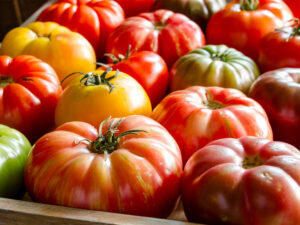The Love Apple
- By Heidi Lewis
- Reading Time: 4 mins.
 The French called the tomato the pomme d’amour, or the Love Apple, for their belief that the exotic tomato had aphrodisiac powers. Tomatoes might not be responsible for romance in people, but eating tomatoes does seem to spark a lust for more tomatoes.
The French called the tomato the pomme d’amour, or the Love Apple, for their belief that the exotic tomato had aphrodisiac powers. Tomatoes might not be responsible for romance in people, but eating tomatoes does seem to spark a lust for more tomatoes.
Tomatoes are a member of the nightshade or Solanaceae family, which includes eggplants, potatoes, tobacco, and peppers. While the tomato is botanically–speaking a fruit, it is culturally—and legally—a vegetable. This fruit versus vegetable question has been debated by everyone from school children to foodies, to the U.S. Supreme court (Nix v. Hedden, 1893). The case concerned an 1883 tariff that was applied to imported vegetables, but not fruit. While the plaintiff argued that botanically the tomato was certainly a fruit, the court ruled unanimously that popular perception and usage (served with dinner, not dessert) dictated the opposite:
“The passages cited from the dictionaries define the word ‘fruit’ as the seed of plants, or that part of plants which contains the seed, and especially the juicy, pulpy products of certain plants, covering and containing the seed. These definitions have no tendency to show that tomatoes are ‘fruit,’ as distinguished from ‘vegetables,’ in common speech, or within the meaning of the tariff act.”, wrote Judge Horace Gray. A botanist at the time commented: “The court rejected the botanical truth that the tomato is in fact a monstrously sized berry, and deferred to the culinary vernacular of vegetable to describe it. This is tax yet paid on imported tomatoes.”
Get tips for your office
Be an office hero!
In 1981, U.S. President Ronald Reagan’s administration proposed that ketchup be classified as a vegetable instead of a condiment for the purposes of saving money on the school lunch program. Following outrage by nutritionists, politicians, and the media, the policy was never implemented.
Tomatoes arrived on our shores in the early 18th century via Europe, where they had arrived only several centuries beforehand via New World explorers. Originating in South America, some species of tomatoes still grow wild in the Andes. By the Victory Garden craze of the late 1940s, the Burpee Seed Company had popularized the homegrown tomato for Americans by creating hybrid varieties that were forgiving to novice gardeners and good producers with firm and classic red fruits, notably the Big Boy Tomato. Today there are more than 7,500 species grown for various purposes and China, the U.S., Turkey, India, and Italy are the largest commercial producers.
Hybrid tomatoes have nonproductive seeds, which means that in order to grow a particular variety again you must buy the seeds again. Heirloom tomatoes are “open-pollinated,” which means insects, birds, the wind, and other natural sources can pollinate them. Their seeds will produce new generations but with variations. Hybrids are not the same as genetically modified (GMO); while some varieties have been bred for pest resistance and other traits, there are currently no GMO tomatoes sold commercially. The only one, the Flavr Savr, was sold from 1994 to 1997 and was not commercially successful.
Want fruit for your office?
Get your office a free sample TODAY!
 Heirloom varieties all have a history—a story—they have been passed from family to friend. Heirlooms not only have great flavors and color, but great names that give homage to their origin, their grower, or, sometimes, just whimsy. From “Aunt Gertie’s Gold,” to “Orange Banana,” to “Zebra,” there are names with stories: the “Polish” is a cultivar said to have been smuggled on the back of a postage stamp; “Besser,” which is German for “better,” came from the Freiburg, Germany; “Brandywine” was developed by Amish farmers near Brandywine Creek in Chester County, PA around 1885; “Broad Ripple Yellow Currant” was found growing in a sidewalk crack in Indianapolis, IN, in 1984; the “Mortgage Lifter” is said to be developed by “Radiator Charlie” Byles in West Virginia, who crossed the four biggest varieties he knew and created a variety that produced such immense, tasty fruit he reportedly was able to pay off his mortgage on the sales.
Heirloom varieties all have a history—a story—they have been passed from family to friend. Heirlooms not only have great flavors and color, but great names that give homage to their origin, their grower, or, sometimes, just whimsy. From “Aunt Gertie’s Gold,” to “Orange Banana,” to “Zebra,” there are names with stories: the “Polish” is a cultivar said to have been smuggled on the back of a postage stamp; “Besser,” which is German for “better,” came from the Freiburg, Germany; “Brandywine” was developed by Amish farmers near Brandywine Creek in Chester County, PA around 1885; “Broad Ripple Yellow Currant” was found growing in a sidewalk crack in Indianapolis, IN, in 1984; the “Mortgage Lifter” is said to be developed by “Radiator Charlie” Byles in West Virginia, who crossed the four biggest varieties he knew and created a variety that produced such immense, tasty fruit he reportedly was able to pay off his mortgage on the sales.
“Coco’s Little Sweet Pear” was bred by Northern California’s Greg House to include all the characteristics he values in tomatoes: high solids, high sugar, high acid, high lycopene, with a superior deep rich true-tomato flavor when used fresh or cooked. He perfected his tomato to thrive in the Solano County climate of his farm and to adapt to his organic farming practices. He named this gem of tomato after his wife Coco. Now that’s love.
Heidi Lewis writes about farms, bees, and fruit from her home in Sonoma County, CA. She’s been with The FruitGuys since they were FruitKids.
Want fruit for your office?
Get your office a free sample TODAY!


